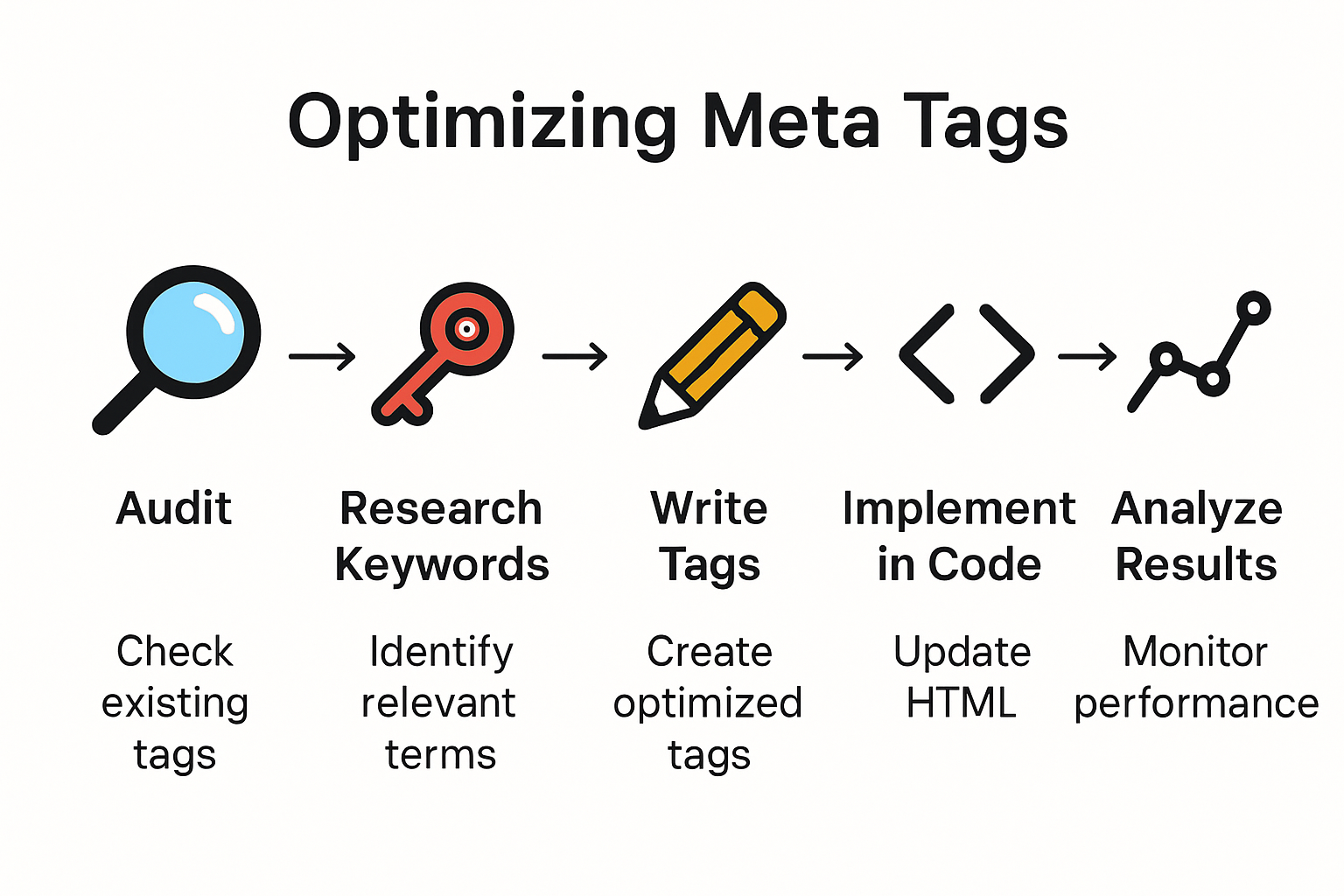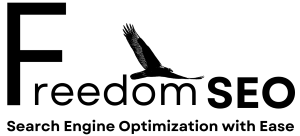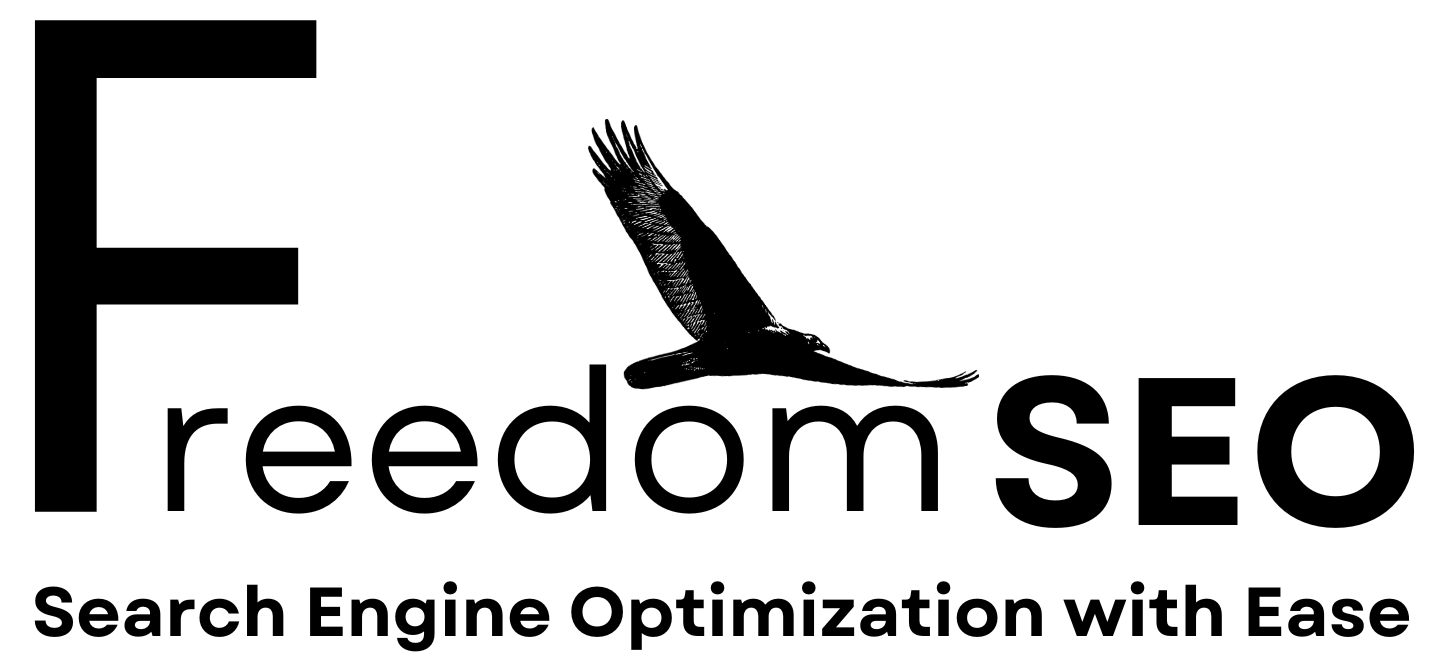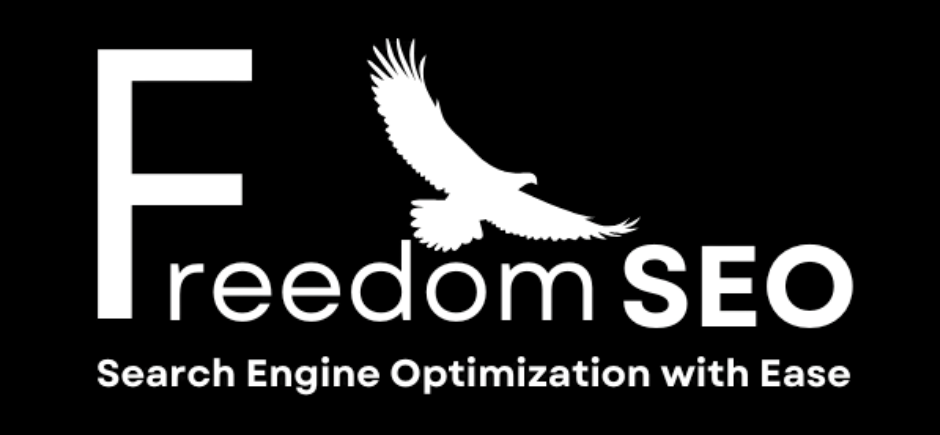How to Optimize Meta Tags for Better SEO Performance

Meta tags are often the first thing people notice about your website in search results and yet they are one of the most overlooked parts of basic website SEO. Some sites see click-through rates double simply by updating meta descriptions and title tags . Most folks think optimizing tags is way too technical or only matters for huge businesses. The truth is that even small tweaks can put your business at the top spot in Google for keywords your customers actually use.
Table of Contents
Quick Summary
| Key Point | Explanation |
|---|---|
| 1. Conduct a Meta Tag Audit | Assess your website’s meta tag performance using tools like Google Search Console to identify strengths and weaknesses. |
| 2. Research Relevant Keywords | Use tools such as Google Keyword Planner to find keywords reflecting user intent, focusing on specific long-tail keywords. |
| 3. Craft Unique Title Tags | Create unique title tags under 60 characters that effectively summarize each page’s content and include primary keywords. |
| 4. Ensure Proper Implementation | Implement meta tags within the HTML “” section accurately to enhance SEO across all pages. |
| 5. Analyze Performance Over Time | Use Google Search Console to track the impact of your changes on click-through rates and adjust as necessary. |

Step 1: Evaluate Your Current Meta Tag Structure
Optimizing meta tags starts with a thorough assessment of your current website’s meta tag performance. This critical first step helps you identify existing strengths and potential areas for improvement in your search engine optimization strategy.
Begin by conducting a comprehensive meta tag audit across your entire website. You’ll want to use free tools like Google Search Console to help analyze your current meta tag structure. This tool provides insights into how search engines currently perceive and index your web pages.
Carefully examine each page’s title tag and meta description . Check for consistency, length, and relevance. Each page should have a unique title tag that accurately represents its content while staying under 60 characters. Meta descriptions should provide a concise summary of the page, compelling users to click, and remain within 160 characters.
Look for common meta tag issues that could be hindering your SEO performance. Red flags to watch for include:
- Duplicate title tags across multiple pages
- Missing meta descriptions
- Overly generic or keyword-stuffed descriptions
- Title tags that do not reflect actual page content
Pay special attention to your most important pages like homepage, service pages, and key landing pages. These should have the most carefully crafted meta tags. Use a spreadsheet or documentation tool to track your findings, noting which pages need immediate attention.
To verify your audit’s effectiveness, check how your pages currently appear in search results. Do the titles and descriptions accurately represent your content? Would they entice a potential visitor to click? If not, you’ve identified areas requiring optimization.
Before updating your meta tags, use this checklist to verify you have followed best practices and caught any common issues discussed in the guide:
| Verification Step | Criteria/Questions | Completed (Yes/No) |
|---|---|---|
| Unique Title Tag for Each Page | Does every page have a distinct title? | |
| Title Tag Length | Is each title under 60 characters? | |
| Relevant Meta Description | Is every meta description specific and relevant? | |
| Meta Description Length | Are meta descriptions under 160 characters? | |
| No Duplicate Content | Are titles/descriptions free from duplication? | |
| Natural Keyword Inclusion | Are keywords included naturally in both tags? | |
| Accurate Reflection of Page Content | Do tags match the page’s actual content? | |
| Preview in Search Results | Do titles/descriptions look appealing in SERPs? |
Check out our quick wins for Canadian marketers to learn more advanced techniques for refining your meta tag strategy. Remember, a thorough evaluation sets the foundation for improved search engine visibility and user engagement.
Step 2: Research Relevant Keywords for Your Business
Keyword research forms the foundation of effective meta tag optimization, transforming how potential customers discover your business online. This step requires strategic thinking and careful analysis to uncover the precise search terms your target audience uses when seeking your products or services.
Start by brainstorming core terms directly related to your business offerings. Consider the language your customers actually use, not just industry jargon. Put yourself in their shoes. A plumber might think about “residential pipe repair,” but customers likely search for “fix broken pipe” or “water leak help.”
Utilize powerful keyword research tools to expand and validate your initial ideas. Google Keyword Planner provides free insights into search volumes and competition levels. Another excellent resource is Keyword Explorer , which offers detailed metrics about potential keywords. These tools help you understand not just what people search for, but how frequently and competitively those terms are used.
To help you choose the best resources when optimizing your meta tags, here is a table summarizing the SEO tools and their primary purposes as discussed in the article:
| Tool/Resource | Purpose/Usage | Where to Use |
|---|---|---|
| Google Search Console | Audit meta tags, track organic performance, verify changes | Step 1, Step 5 |
| Google Keyword Planner | Research keyword volume and competition | Step 2 |
| Moz Keyword Explorer | Find keyword opportunities, assess relevance and intent | Step 2 |
| Yoast SEO (WordPress plugin) | Input and manage meta tags via a user interface | Step 4 |
| RankMath (WordPress plugin) | Customize meta tags on WordPress sites | Step 4 |
| Website builders (Wix, Squarespace, Shopify) | Modify meta tags in site SEO/Page Settings | Step 4 |
| Google Analytics | Analyze user behaviour after click-through | Step 5 |
Key considerations for keyword selection include:
- Search volume (how many people search this term monthly)
- Competition level for the keyword
- Relevance to your specific business offerings
- User intent behind the search
Focus on long-tail keywords - more specific, typically longer phrases that demonstrate clear user intent. Instead of “website design,” target “affordable small business website design in Manitoba.” These specific phrases often have less competition and higher conversion potential.
Learn more about DIY SEO strategies for Canadian businesses to refine your approach. Remember, effective keyword research is about quality over quantity. You want keywords that genuinely represent your business and attract your ideal customers.
To verify your keyword research, check if the selected terms align with your business goals and appear naturally in your content. The right keywords should feel like a perfect match for what you offer, bridging the gap between your business and potential customers’ search behaviors.
Step 3: Write Compelling Title Tags and Meta Descriptions
Crafting engaging title tags and meta descriptions is an art form that directly impacts your website’s search engine visibility and click-through rates. These critical elements serve as your digital storefront, enticing potential visitors to choose your page over countless competitors.
Begin by creating unique title tags for each webpage. Your title should be a concise, powerful summary that includes your primary keyword while speaking directly to user intent. Think of it as a headline that must grab attention in less than 60 characters. For example, instead of “Plumbing Services,” use “Emergency Pipe Repair - Fast 24/7 Service in Manitoba.”
Meta descriptions require an equally strategic approach. These 160-character summaries should read like a compelling advertisement for your webpage. Communicate value, spark curiosity, and include a clear call-to-action. Describe exactly what a user will gain by clicking through. A generic description like “We offer great services” transforms into “Save 20% on professional plumbing repairs. Certified technicians solve your home’s toughest pipe problems in under 2 hours.”
Critical elements for effective meta tags include:
- Incorporating primary keywords naturally
- Matching user search intent precisely
- Creating unique descriptions for each page
- Avoiding duplicate content across your website
Pay special attention to your most important pages - homepage, service pages, and key landing pages. These deserve extra time and creativity in crafting meta tags that truly represent your business’s unique value proposition.
Explore our comprehensive guide to DIY SEO strategies for more advanced optimization techniques. Remember, great meta tags are about balance - they must satisfy both search engine algorithms and human curiosity.
To verify your meta tag effectiveness, preview how they appear in search results. Would you click on this description if you were a potential customer? If the answer is no, keep refining until the text becomes irresistibly engaging.
Step 4: Implement Meta Tags in Your Website’s Code
Implementing meta tags requires precision and technical understanding. This step transforms your carefully researched keywords and crafted descriptions into actual code that search engines will read and understand. Your goal is to seamlessly integrate meta tags across your entire website, ensuring each page communicates its unique purpose effectively.
For WordPress websites, the process is relatively straightforward. Most SEO plugins like Yoast SEO or RankMath provide user-friendly interfaces where you can input title tags and meta descriptions directly. These tools allow you to customize meta tags for individual pages without touching the underlying HTML code. Simply navigate to each page, locate the SEO settings, and input your optimized title and description.
For those managing websites with custom HTML, you’ll need to work directly within the page’s code. Insert meta tags in the <head>
section of your HTML document.
The basic structure looks like this: <title>Your Page Title</title>
and <meta name="description" content="Your compelling description">
. Each page requires its own unique meta tags to maximize search engine optimization potential.
Essential implementation guidelines include:
- Ensure meta tags are unique for every webpage
- Place tags within the HTML
<head>section - Avoid duplicate content across different pages
- Use primary keywords naturally within tags
Website builders like Wix, Squarespace, and Shopify typically offer built-in SEO settings where you can easily modify meta tags without extensive coding knowledge. Look for sections labeled “SEO Settings” or “Page Settings” to make your modifications.
Explore our quick SEO wins for Canadian marketers to further refine your approach. Remember that consistent, accurate meta tag implementation is key to improving your website’s search engine visibility.
To verify successful implementation, use tools like Google Search Console or preview your pages in search results. Your meta tags should appear exactly as you designed them, providing a clear, compelling snapshot of each webpage’s content and purpose.

Step 5: Test and Analyze the Impact of Your Changes
Testing and analyzing your meta tag optimization is crucial to understanding their real-world performance. This final step transforms your strategic efforts into measurable insights, helping you continually refine your approach and improve search engine visibility.
Google Search Console becomes your primary analytical tool in this process. After implementing your new meta tags, wait approximately two to four weeks to allow search engines sufficient time to crawl and index your updated pages. Then, dive deep into the console’s performance reports. Look specifically at click-through rates, impressions, and average search positioning for pages where you’ve made meta tag modifications.
Your primary metrics of success include organic click-through rate (CTR) and search result positioning. A well-optimized meta tag should see incremental improvements in these areas. If a specific page’s CTR increases from 2% to 4% after your changes, that’s a clear indicator of effective optimization. Conversely, if you notice no change or a decline, you may need to revisit your keyword research or meta tag crafting strategy.
Key performance indicators to monitor include:
- Organic search impressions
- Click-through rates
- Average search positioning
- Bounce rates from search results
Utilize additional tools like Google Analytics to gain deeper insights. Track user behavior after they click through from search results. Are users spending more time on your pages? Are they exploring multiple sections of your website? These behavioural metrics provide context beyond raw search performance data.
Discover more advanced SEO tracking techniques to further refine your approach. Remember that SEO is an ongoing process of testing, learning, and adapting.
To verify success, create a spreadsheet tracking your meta tag changes and corresponding performance metrics. Document initial and subsequent performance levels, noting any significant shifts. This record becomes your strategic roadmap, helping you understand what works best for your specific website and audience. Successful meta tag optimization is not about achieving perfection, but about consistent, incremental improvements that compound over time.
Take the Guesswork Out of Meta Tag Optimization and Get Real Results
Struggling to turn optimized meta tags into actual search traffic and leads for your business? You are not alone. Many Canadian business owners realize that simply tweaking titles and descriptions is not enough. Effective SEO means understanding the search landscape, using the right keywords, and connecting every step to bigger business goals—yet this process can feel overwhelming and time-consuming.
What if you could stop second-guessing every update and see your site consistently climb to the top three on Google? The team at Freedom SEO blends local expertise with hands-on strategies tailored to Canadian businesses. We take those core concepts you just learned—like thorough audits, precise keyword research, and proven meta tag practices—and turn them into sustainable rankings and new leads.

Ready to bridge the gap between theory and results? Let us handle the technical challenges and deliver fast, measurable improvements. Contact Freedom SEO today to claim your spot among the top performers in your market. Explore our Managed SEO Services and see why Canadian businesses trust us for guaranteed results, quick turnarounds, and a personalized local touch. Act now to secure your path to greater visibility and growth.
Frequently Asked Questions
How do I evaluate my current meta tag performance?
You can evaluate your current meta tag performance by conducting a comprehensive meta tag audit using tools like Google Search Console. This will help you analyze the title tags and meta descriptions of your pages for consistency, length, and relevance.
What tools can I use for keyword research related to meta tags?
Popular keyword research tools include Google Keyword Planner and Moz’s Keyword Explorer. These tools provide insights into search volumes, competition levels, and user intent, helping you choose the right keywords for your meta tags.
What are the best practices for writing effective title tags?
For effective title tags, ensure they are unique for each webpage, incorporate primary keywords naturally, and keep them under 60 characters. Make your title engaging and reflective of the page’s content to improve click-through rates.
How can I test the impact of my meta tags on SEO?
To test the impact of your meta tags, use Google Search Console to monitor metrics like click-through rates, organic search impressions, and average search positioning. Analyze the performance after implementing your changes to measure success.
Recommended
-
[
Top SEO Quick Wins for Canadian DIY Marketers in 2025
]( https://freedomseo.ca/top-seo-quick-wins-for-canadian-diy-marketers-in-2025 )
-
[
How Web Design Affects SEO: Tips for Canadian Businesses 2025
]( https://freedomseo.ca/how-web-design-affects-seo-tips-for-canadian-businesses-2025 )
-
[
Writing Blog Posts for SEO: 2025 Tips for Canadian DIYers
]( https://freedomseo.ca/writing-blog-posts-for-seo-2025-tips-for-canadian-diyers )
-
[
Essential Image Optimization SEO Tips for Canadians
]( https://freedomseo.ca/essential-image-optimization-seo-tips-for-canadians )

















